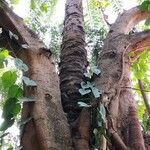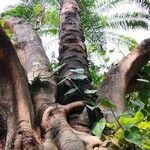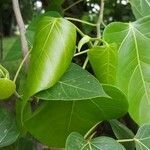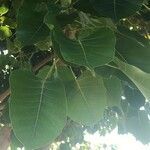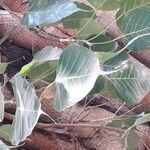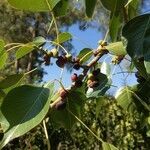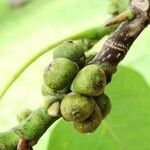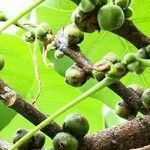| Therapeutic use
|
Abdominal pain (bark), Abscess (bark), Hair loss (bark), Analgesics (bark), Anthelmintics (bark), Anti-bacterial agents (bark), Antifungal agents (bark), Anti-infective agents, local (bark), Anti-inflammatory agents (bark), Antioxidants (bark), Antiprotozoal agents (bark), Antipyretics (bark), Antirheumatic agents (bark), Antiviral agents (bark), Aphrodisiacs (bark), Asthma (bark), Astringents (bark), Blister (bark), Burns (bark), Cathartics (bark), Cholinergic antagonists (bark), Colic (bark), Common cold (bark), Cough (bark), Dental caries (bark), Dermatitis (bark), Dermatologic agents (bark), Diabetes mellitus (bark), Diarrhea (bark), Digestive system diseases (bark), Dysentery (bark), Dyspepsia (bark), Earache (bark), Edema (bark), Fatigue (bark), Fertility agents, female (bark), Fistula (bark), Fractures, bone (bark), Furunculosis (bark), Gastroschisis (bark), Genital diseases, female (bark), Gonorrhea (bark), Gout (bark), Halitosis (bark), Hematuria (bark), Hemorrhage (bark), Hemorrhoids (bark), Hemostasis (bark), Hypoglycemic agents (bark), Hypolipidemic agents (bark), Immunomodulation (bark), Inflammation (bark), Insecticides (bark), Jaundice (bark), Laxatives (bark), Leukorrhea (bark), Liver diseases (bark), Mastitis (bark), Mastodynia (bark), Menorrhagia (bark), Mouth diseases (bark), Nervous system diseases (bark), Pain (bark), Periodontal diseases (bark), Pharyngitis (bark), Pruritus (bark), General tonic for rejuvenation (bark), Relaxation (bark), Scabies (bark), Skin care (bark), Skin diseases (bark), Snake bites (bark), Stomatitis (bark), Suppuration (bark), Tetanus (bark), Thirst (bark), Toothache (bark), Ulcer (bark), Urinary tract infections (bark), Urologic diseases (bark), Vaginal diseases (bark), Vomiting (bark), Whooping cough (bark), Wounds and injuries (bark), Endocrine system diseases (bark), Cooling effect on body (bark), Skin diseases (flower), Amnesia (fruit), Analgesics (fruit), Anti-bacterial agents (fruit), Anticonvulsants (fruit), Antidotes (fruit), Antifungal agents (fruit), Anti-infective agents (fruit), Anti-inflammatory agents (fruit), Antineoplastic agents (fruit), Antioxidants (fruit), Antipyretics (fruit), Asthma (fruit), Astringents (fruit), Cathartics (fruit), Constipation (fruit), Diabetes mellitus (fruit), Diarrhea (fruit), Digestive system diseases (fruit), Dysentery (fruit), Hypercholesterolemia (fruit), Laxatives (fruit), Leukorrhea (fruit), Nervous system diseases (fruit), General tonic for rejuvenation (fruit), Spasm (fruit), Ulcer (fruit), Uterine diseases (fruit), Vomiting (fruit), Wounds and injuries (fruit), Cooling effect on body (fruit), Abdominal pain (leaf), Abortifacient agents (leaf), Acne vulgaris (leaf), Analgesics (leaf), Anthelmintics (leaf), Anti-bacterial agents (leaf), Antifungal agents (leaf), Anti-infective agents (leaf), Anti-inflammatory agents (leaf), Antinematodal agents (leaf), Antineoplastic agents (leaf), Antioxidants (leaf), Antipyretics (leaf), Aphrodisiacs (leaf), Asthma (leaf), Astringents (leaf), Blister (leaf), Burns (leaf), Cardiotonic agents (leaf), Cathartics (leaf), Cough (leaf), Diabetes mellitus (leaf), Diarrhea (leaf), Digestive system diseases (leaf), Dysentery (leaf), Dyspepsia (leaf), Earache (leaf), Edema (leaf), Disorder of ejaculation (leaf), Epistaxis (leaf), Toothache (root), Estrogen receptor modulators (leaf), Exanthema (leaf), Fever (leaf), Furunculosis (leaf), Gonorrhea (leaf), Hematologic diseases (leaf), Hematuria (leaf), Hemoptysis (leaf), Hemorrhoids (leaf), Insecticides (leaf), Jaundice (leaf), Laxatives (leaf), Menorrhagia (leaf), Metrorrhagia (leaf), Nausea (leaf), Nervous system diseases (leaf), Pleurisy (leaf), Pneumonia (leaf), Psoriasis (leaf), General tonic for rejuvenation (leaf), Scabies (leaf), Skin diseases (leaf), Snake bites (leaf), Stomach diseases (leaf), Ulcer (leaf), Vomiting (leaf), Wound healing (leaf), Wounds and injuries (leaf), Fissure (plant exudate), Abscess (plant exudate), Analgesics (plant exudate), Anti-bacterial agents (plant exudate), Antifungal agents (plant exudate), Anti-inflammatory agents (plant exudate), Antioxidants (plant exudate), Antipyretics (plant exudate), Asthma (plant exudate), Astringents (plant exudate), Cough (plant exudate), Diabetes mellitus (plant exudate), Diarrhea (plant exudate), Digestive system diseases (plant exudate), Dysentery (plant exudate), Furunculosis (plant exudate), Hemorrhage (plant exudate), Inflammation (plant exudate), Jaundice (plant exudate), Kidney diseases (plant exudate), Laxatives (plant exudate), Neuralgia (plant exudate), Pain (plant exudate), Psoriasis (plant exudate), General tonic for rejuvenation (plant exudate), Skin diseases (plant exudate), Ulcer (plant exudate), Wounds and injuries (plant exudate), Hair loss (root), Analgesics (root), Anti-bacterial agents (root), Antifungal agents (root), Anti-inflammatory agents (root), Antioxidants (root), Antipyretics (root), Asthma (root), Astringents (root), Chickenpox (root), Common cold (root), Constipation (root), Diabetes mellitus (root), Diarrhea (root), Digestive system diseases (root), Dysentery (root), Elephantiasis (root), Hemorrhoids (root), Infertility (root), Jaundice (root), Laxatives (root), Malaria (root), Skin diseases (root), Snake bites (root), Stomatitis (root), Ulcer (root), Analgesics (seed), Anti-bacterial agents (seed), Antifungal agents (seed), Anti-inflammatory agents (seed), Antioxidants (seed), Antipyretics (seed), Asthma (seed), Astringents (seed), Diabetes mellitus (seed), Diarrhea (seed), Digestive system diseases (seed), Dysentery (seed), Hematologic diseases (seed), Hemorrhoids (seed), Laxatives (seed), Menstruation (seed), Menstruation disturbances (seed), Pregnancy complications (seed), General tonic for rejuvenation (seed), Sterilization, reproductive (seed), Ulcer (seed), Urination disorders (seed), Cooling effect on body (seed), Astringents (shoot), Cathartics (shoot), Scabies (shoot), Skin diseases (shoot), Wounds and injuries (shoot), Anti-bacterial agents (stem), Common cold (stem), Constipation (stem), Cough (stem), Fever (stem), Furunculosis (stem), Laxatives (stem), Skin diseases (stem), Snake bites (stem), Toothache (stem), Alterative (unspecified), Astringent (unspecified), Atrophy (unspecified), Cachexia (unspecified), Carbuncle (unspecified), Cholera (unspecified), Dysuria (unspecified), Fever (unspecified), Gonorrhea (unspecified), Gravel (unspecified), Laxative (unspecified), Otitis (unspecified), Purgative (unspecified), Refrigerant (unspecified), Rheumatism (unspecified), Rinderpest (unspecified), Smallpox (unspecified), Sore (unspecified), Spermatorrhea (unspecified), Stomatitis (unspecified), Tumor (unspecified), Urogenital (unspecified), Pimple (unspecified), Skin (unspecified), Bactericide (unspecified), Bowel (unspecified), Dysentery (unspecified), Abdominal pain (unspecified), Angiotensin-converting enzyme inhibitors (unspecified), Antirheumatic agents (unspecified), Asthma (unspecified), Astringents (unspecified), Colic (unspecified), Constipation (unspecified), Diabetes mellitus (unspecified), Diarrhea (unspecified), Disorder of ejaculation (unspecified), Emaciation (unspecified), Expectorants (unspecified), Fatigue (unspecified), Hypoglycemic agents (unspecified), Inflammatory bowel diseases (unspecified), Kidney calculi (unspecified), Laxatives (unspecified), Otitis media, suppurative (unspecified), General tonic for rejuvenation (unspecified), Scabies (unspecified), Stomatitis, aphthous (unspecified), Ulcer (unspecified), Mucus in urine (unspecified), Wounds and injuries (unspecified), Central nervous system stimulants (unspecified), Rheumatoid arthritis (unspecified), Asthma (whole plant excluding root)
|
